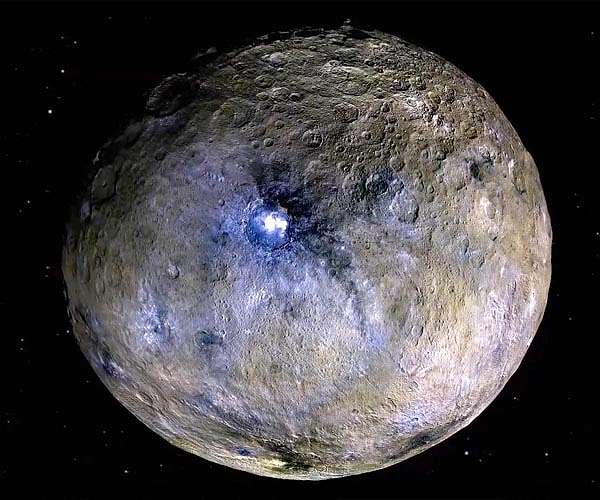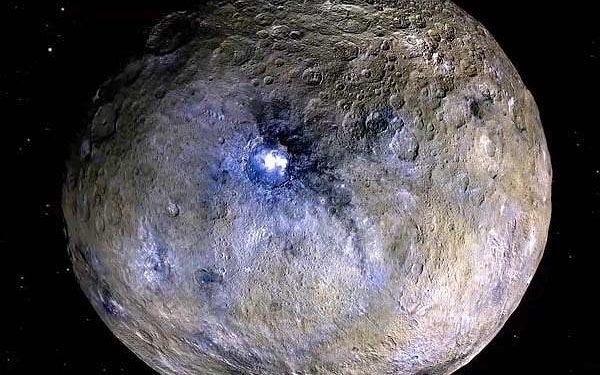
Hypervelocity impact experiments probe the origin of organics on the dwarf planet Ceres
by Staff Writers
Pittsburgh PA (SPX) Oct 17, 2023
One of the most exciting findings from NASA’s Dawn mission is that Ceres, the largest object in the asteroid belt that lies between Mars and Jupiter, hosts complex organics. The discovery of aliphatic molecules, which consist of carbon and hydrogen chains, in conjunction with evidence that Ceres has abundant water ice and may have been an ocean world, means this dwarf planet might have once harbored the main ingredients associated with life as we know it.
How the aliphatic organics originated on Ceres has been the subject of intensive research since their discovery in 2017. Some studies have concluded that a comet or other organic-rich impactor delivered them to Ceres; others indicate the molecules formed on the dwarf planet after its primordial materials were altered by briny water. But regardless of their origin, the organics on Ceres have been affected by the pervasive impacts that have pockmarked its surface.
Now new research to be presented Tuesday at the Geological Society of America’s GSA Connects 2023 meeting is extending scientists’ understanding of how impacts have affected Ceres’ aliphatic molecules-and what the implications are for determining their origin and assessing the dwarf planet’s habitability.
“The organics were initially detected in the vicinity of a large impact crater, which is what motivated us to look at how impacts affect these organics,” says Terik Daly, a planetary scientist at the Johns Hopkins Applied Physics Laboratory who led this study. “We are finding that organics may be more widespread than first reported and that they seem to be resilient to impacts with Ceres-like conditions.”
Capitalizing On Multiple Datasets
From the Dawn data, Daly knew that Ceres is covered with impact craters of varying sizes formed when other asteroids slammed into Ceres. But what he did not yet understand was how these impacts affect aliphatic compounds-information that was needed to help constrain where the organics originated and how their signatures might have changed after being exposed to multiple impacts over billions of years.
“Although researchers have performed impact and shock experiments on various types of organics in the past,” says Daly, “what was missing was a study dedicated to the type of organics detected on Ceres using the same type of analytical method used by the Dawn spacecraft to detect them.” This, he says, would enable direct comparisons between the experimental and spacecraft data.
Daly worked with a team that included Jessica Sunshine, an astronomer at the University of Maryland, and Juan Rizos, a postdoctoral researcher at the University of Maryland who is now an astrophysicist at the Instituto de Astrofisica de Andalucia in Spain, to conduct a series of experiments at the NASA Ames Vertical Gun Range. The experiments mimicked the impact conditions typical of Ceres, with impact speeds ranging between 2-6 km/s (4,400-13,000 mph) and impact angles varying between 15 and 90 degrees relative to horizontal.
Rizos and Sunshine also conducted a new analysis that combined data from two different instruments-the camera and the imaging spectrometer that flew on the Dawn spacecraft-and then used an algorithm to extrapolate the compositional information from the spectrometer down to the camera’s higher spatial resolution. The results allowed them to investigate the organics at finer detail than has previously been possible.
“People had looked at the Dawn camera data and the Dawn spectrometer data separately, but no one else had taken the approach our team used to extrapolate the data from one instrument to another, which provided new leverage in our search to map and understand the origin of organics on Ceres,” says Sunshine.
Evidence For An Internal Origin
Collectively, the team’s analyses point to some potentially exciting results.
“By capitalizing on the strengths of two different datasets collected over Ceres, we’ve been able to map potential organic-rich areas on Ceres at higher resolution,” says Rizos. “We can see a very good correlation of organics with units from older impacts and with other minerals like carbonates that also indicate the presence of water. While the origin of the organics remains poorly understood, we now have good evidence that they formed in Ceres and likely in the presence of water.”
“There is a possibility that a large interior reservoir of organics may be found inside Ceres,” adds Rizos. “So, from my perspective, that result increases the astrobiological potential of Ceres.”
The researchers hope the results from another NASA mission called Lucy will soon shed more light on organics in the solar system. Sunshine is also a part of that mission’s team and has been thinking about how to apply the results of the current study to the asteroids that Lucy will be studying in the vicinity of Jupiter. “We will likely find differences, as the Trojan asteroids have experienced very different impact histories from Ceres, and because there are two compositionally different types of Trojan asteroids. Comparisons to Ceres will help up us understand the distribution of organics in the outer solar system,” she says.
For all the team members, these results have heightened the expectations for another mission to Ceres. In the latest Planetary Science and Astrobiology Decadal Survey, “The U.S. National Academy of Sciences has endorsed a sample return from Ceres in the short list of high-priority mission targets,” says Rizos. “If that happens, it will be several decades in the future. Novel analyses of existing data are a great way of making new discoveries in the meantime.”
Research Session:The Effects of Impacts on the Reflectance Spectra of Aliphatic Organics: Implications for Ceres
Related Links
University of Maryland
Asteroid and Comet Mission News, Science and Technology
